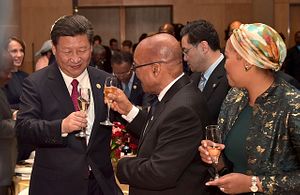The Rebalance authors Mercy Kuo and Angie Tang regularly engage subject-matter experts, policy practitioners and strategic thinkers across the globe for their diverse insights into the U.S. rebalance to Asia. This conversation with Dr. Lucy Corkin – Adviser at RMB Westport – a real estate equity investment joint-venture, focusing on property developments in sub-Saharan Africa – Research Associate of the Africa-Asia Centre at School of African and Asian Studies (SOAS), University of London, and author of Uncovering African Agency: Angola’s Management of China’s Credit Lines (Ashgate 2013) – is the 27th in “The Rebalance Insight Series.”
What are the key pillars of China’s Africa strategy?
Aside from the obvious imperative to expand and diversify access to natural resources, African countries are viewed as markets for Chinese goods and services (as regards the latter, construction engineering contracts have been of particular importance). Along this vein, the African leg of China’s “Going Global” strategy has seen African economies acting as testing grounds for aspirant Chinese multinationals wanting to cut their teeth in overseas markets. In some cases, the Chinese state has facilitated access to African markets with bilateral government agreements, in order to incentivize larger Chinese enterprises with a dominant domestic market position to venture into cross-border operations. From a geopolitical vantage point, African countries have also thus been key in China’s “soft power” outreach as regards developing an arena in which China can exercise an increasingly active foreign policy as a systemically important state.
In what way is China offering an alternative vision for development in Africa?
As a development partner China was first and foremost originally seen as a true alternative to the more established development finance architecture represented by the Bretton Woods institutions. China’s increased footprint in Africa has also shifted the emphasis of development funding back to infrastructure development to facilitate economic growth, rather than the development of political institutions and social spending.
At the December 2015 China Africa Summit in Johannesburg, President Xi Jinping announced additional capital allocation to the China-Africa Development Fund ($10 billion) and China Development Bank (CDB)-funded African Development Special SME – small and medium enterprise – ($6 billion) and launch of the China-Africa Industrial Cooperation Fund ($10 billion). Please identify and assess which sectors will benefit from these funds’ investments.
The China-Africa Development Fund has in the past targeted a variety of sectors, however a closer reading of the Johannesburg Action Plan (2016-2018) and comments from CDB chairman Hu Huaibang seem to indicate an intention to direct funds to infrastructure development, a cornerstone of the China-Africa relationship; industrial development and manufacturing capability; and agricultural projects. This is borne out by the fact that previous CDB-backed SME funding has focused on agri-projects as a sector which has a direct bearing on lower-income households. The launch of the China-Africa Industrial Cooperation Fund is a formalization of a trend, slowing gathering pace, albeit from a low base, of Chinese companies establishing assembly and manufacturing bases in Africa as operating costs increase in China’s industrialized eastern provinces.
Approximately 40 percent of China-African trade transactions are renminbi-denominated. What is the trajectory of future RMB-based bilateral trade?
The debate surrounding the internationalization of the renminbi regained momentum when the IMF included the renminbi in its currency basket for special drawing rights (SDR) in late 2015. In the context of African countries, this may encourage further African central banks to include the renminbi as a reserve currency; several of which already do. Furthermore, since South Africa and Kenya, as regional powerhouses, have as of late 2015 both established clearing houses for renminbi transactions, the infrastructure is in place to continuously increase renminbi-denominated trade, reducing the need for dollar settlements. Indeed, Ghanaian banks are now authorized to sell renminbi and Zimbabwe has added the renminbi to the basket of currencies that may be used as legal tender following the collapse of the Zimbabwean dollar in 2009. As such developments continue the volume of renminbi-based trade is set to increase. However, the rate of increase depends on the pace at which the renminbi becomes acceptable tender in African markets given convertibility issues and the norm of using dollars as a third-party currency.
What are the strategic implications for Washington as Beijing ramps up soft power tools to internationalize China’s influence across Africa?
This depends entirely on Washington’s strategic outlook for Africa. Washington’s view of African countries as strategic priorities has waxed and waned since Beijing, in the late nineties, renewed its impetus to engage, both politically and economically, with the Africa as it did so with the rest of the world. First viewed purely as a competitor for strategic resources on the continent, Washington may now view Chinese influence in Africa as more nuanced. However, as it currently stands, Washington retains significant and arguably better-developed soft power capital on the continent than Beijing. The onus is on the United States to renew and maintain this position, as China continues to invest in an international soft power strategy.

































